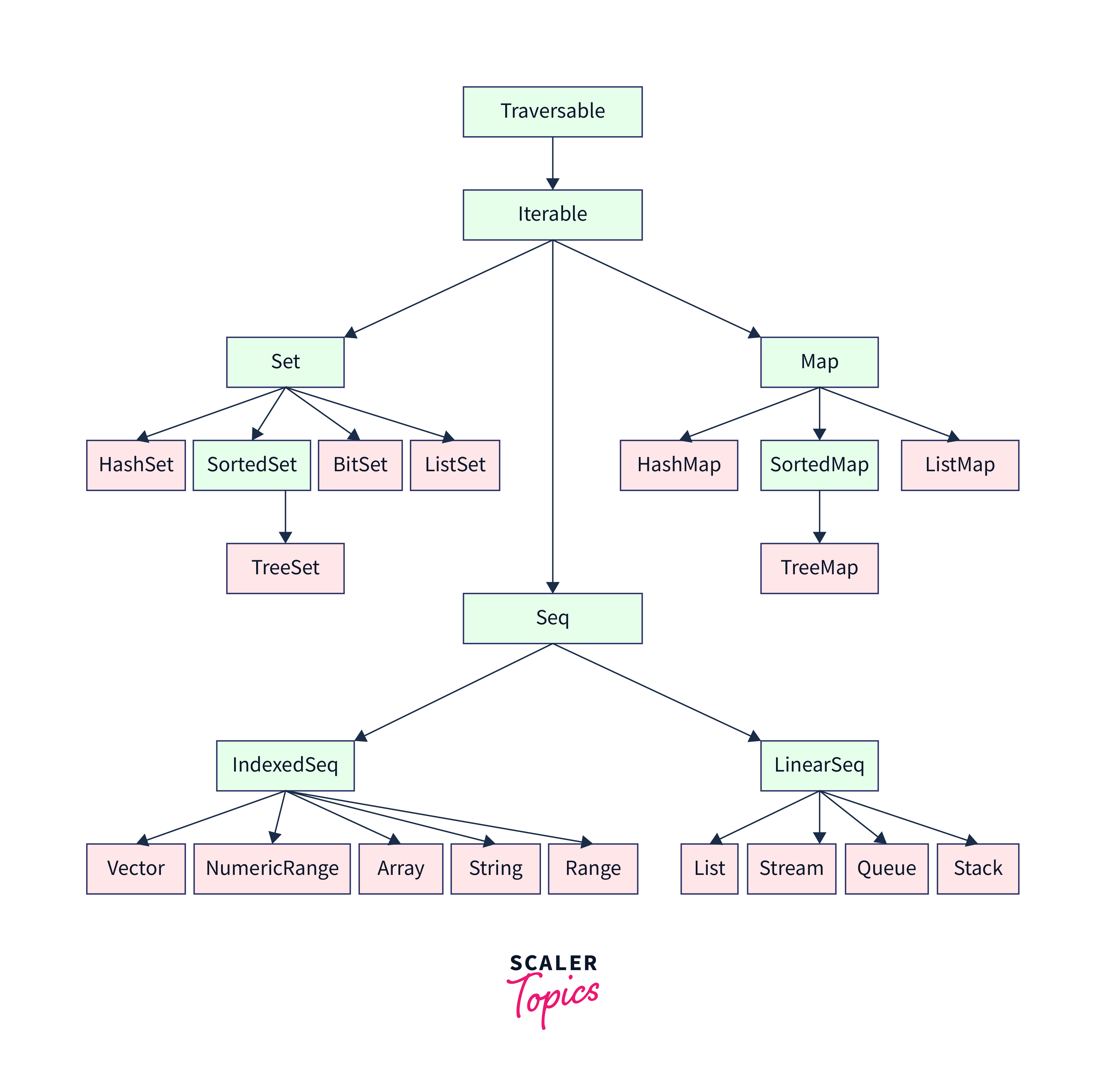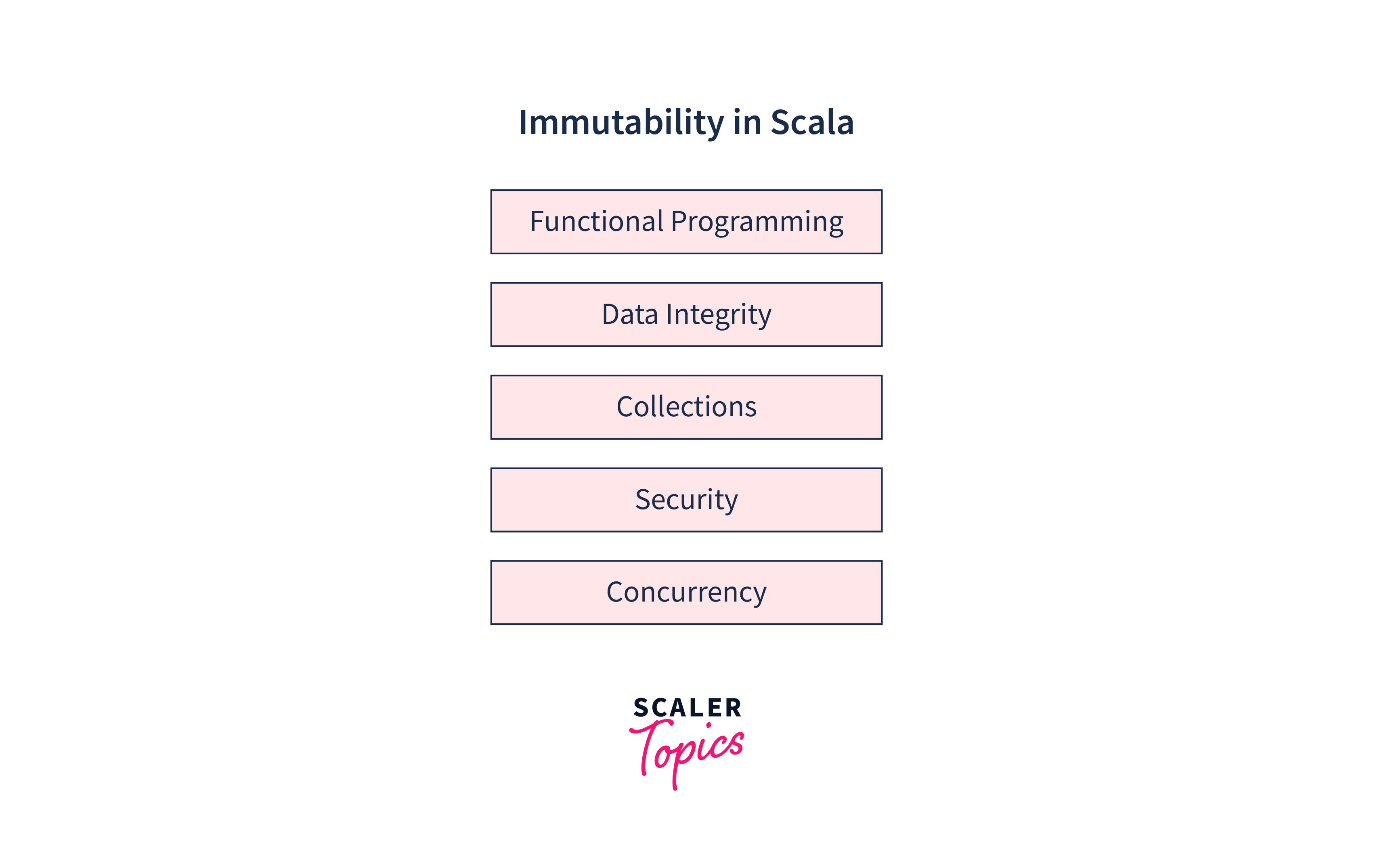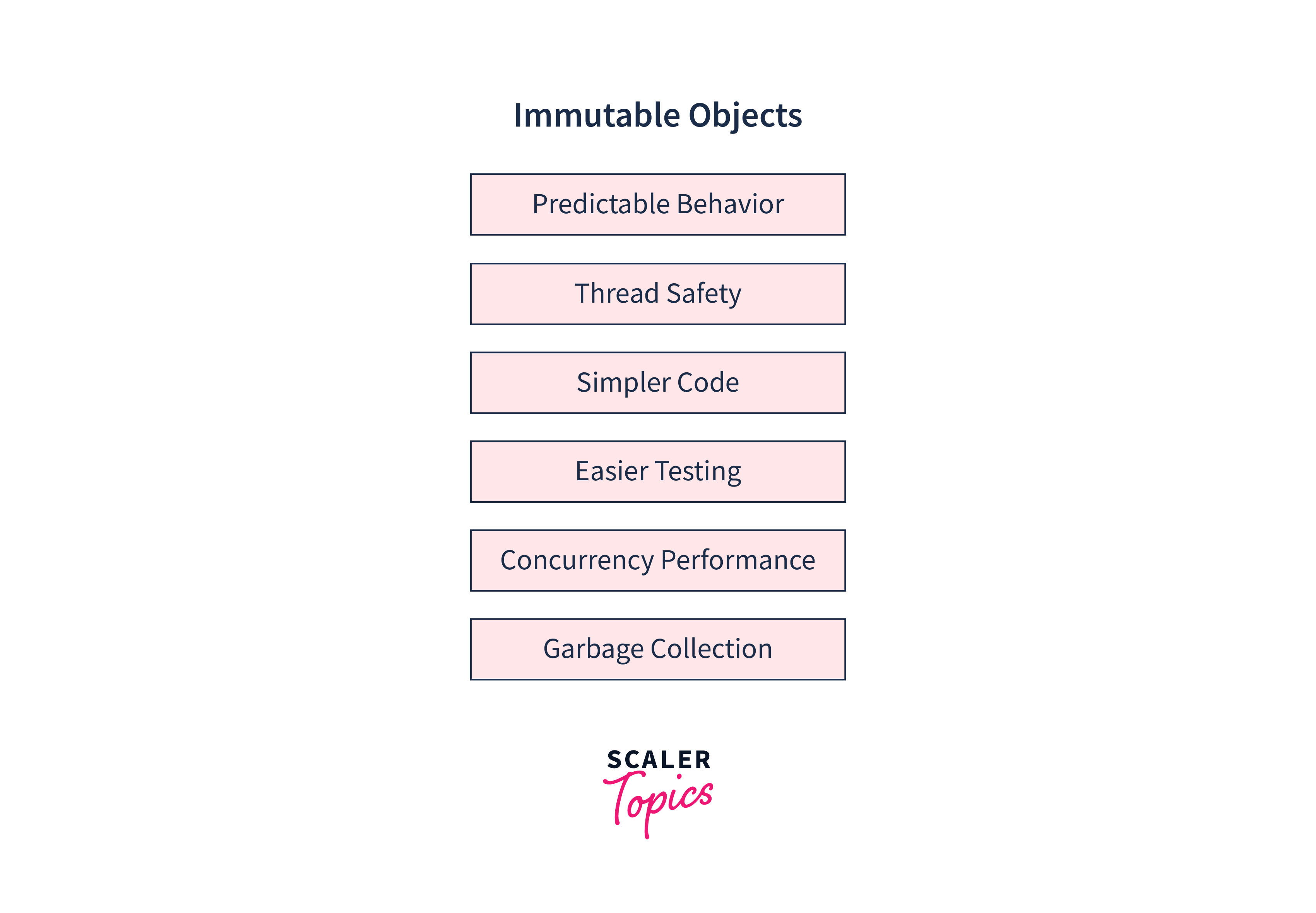Immutability in Scala
Overview
Immutability refers to the property of an object that, once created, cannot be modified. In other words, an immutable object's state remains constant throughout its lifetime. Instead of changing the object's state, we create new objects with modified values. Immutability is important for writing safe and concurrent code and is often associated with functional programming principles. Immutability is encouraged in Scala, and the language provides several features and mechanisms to support it.
Mutable and Immutable Collections
Overview of Collection API
The Collection API in Scala is a comprehensive and powerful framework for working with collections of data. Collections in Scala are divided into two main categories: mutable and immutable. The API provides a wide range of collection types, each tailored for specific use cases and with a unified and consistent set of methods for manipulation and transformation.

Immutable Collections:
-
Lists (List):
Immutable sequences of elements with fast access to the head and tail. Lists are constructed recursively, making them suitable for functional programming. -
Sets (Set):
Immutable collections of distinct elements. Sets can be used for efficient membership tests and provide various set operations. -
Maps (Map):
Immutable key-value mappings. Maps are useful for associating keys with values and performing lookups. -
Sequences (Seq):
The parent trait for all sequences in Scala, including lists, vectors, and other ordered collections. -
Vectors (Vector):
An immutable, high-performance, indexed sequence that provides efficient random access. -
Tuples (TupleN):
Immutable sequences with a fixed number of elements (up to 22). Tuples are often used for grouping values.
Mutable Collections:
-
Mutable Lists (ListBuffer, ArrayBuffer):
Lists that can be modified in place. They are typically used when we need to perform a large number of modifications. -
Mutable Sets (mutable.Set):
Sets that can be modified in place. They allow the addition and removal of elements efficiently. -
Mutable Maps (mutable.Map):
Maps that can be modified in place. They allow updating key-value pairs directly. -
Array:
A mutable, fixed-size sequence with fast random access. Arrays are provided by Scala's standard library and Java interoperability.
Common Collection Methods:
The Collection API provides a consistent set of methods for both mutable and immutable collections. These methods include:
-
Transformation Methods:
Operations like map, filter, flatMap, and collect for transforming and filtering elements. -
Aggregate Methods:
Functions like foldLeft, foldRight, reduce, and sum for aggregating elements. -
Grouping Methods:
Operations like groupBy for grouping elements based on a criterion. -
Sorting and Ordering:
Functions like sorted, sortBy, and reverse for ordering and sorting elements. -
Access and Modification:
Methods for accessing and modifying elements in collections, such as head, tail, apply, update, and more. -
Concatenation and Combining:
Operations for concatenating and merging collections, such as ++, zip, and union. -
Conversion:
Methods for converting between different collection types. -
Iterators and Iteration:
The Collection API provides iterators and convenient ways to iterate over collection elements using foreach, for comprehensions, and other constructs.
Collections Hierarchy:
The Scala Collection API forms a hierarchy where specific collection types inherit from more general ones. The hierarchy includes Iterable, Seq, Set, Map, and more, with both mutable and immutable variants for most collection types. This hierarchical structure simplifies the selection of appropriate collections for different use cases.
Concurrent Programming
Immutability plays a crucial role in concurrent and parallel programming in Scala due to its ability to simplify and enhance the safety of multithreaded environments. Here's a brief elaboration:
-
Predictable State:
Immutability ensures that data cannot change after creation, making concurrent programming more predictable and reducing the risk of race conditions. -
Eliminating Shared State:
Immutable objects reduce the need for shared mutable data, minimizing the complexity of synchronization mechanisms. -
Safe Sharing:
Immutable objects can be safely shared between threads without concerns about concurrent modifications, simplifying concurrent programming. -
Parallelism:
Immutability simplifies parallel programming by eliminating the need for locks and providing clear data separation. -
Functional Concurrency:
Immutability, combined with functional programming in Scala, facilitates the creation of side-effect-free functions, suitable for efficient parallel execution in multi-core environments.
Use of "val" and "var"
In Scala, "val" and "var" are used to declare variables, but they have different implications for immutability:
-
val (Immutable):
Variables declared with val are immutable, meaning their values cannot be changed once assigned. This promotes a safer and more predictable code and is the preferred choice when we want to ensure that a variable's value remains constant. -
var (Mutable):
Variables declared with var are mutable, allowing their values to be modified after assignment. While var offers flexibility, it can lead to unexpected changes and should be used with caution, primarily when there's a genuine need for the mutable state.
Functional Programming Principles
Immutability is fundamental to functional programming in Scala because it ensures that data remains constant once created, promoting:
-
Referential Transparency:
Immutability supports referential transparency, where a function's output depends only on its inputs, simplifying reasoning and debugging. -
Pure Functions:
Immutable data and pure functions, free of side effects, lead to code that's predictable, testable, and less error-prone. -
Functional Composition:
Immutability allows for easy composition of functions, simplifying the creation of complex, reusable, and understandable systems in Scala's functional programming paradigm.
Data Integrity and Security
Immutability in Scala is crucial for maintaining data integrity and security by ensuring that once data is created, it cannot be tampered with or modified. This prevents accidental or malicious alterations, making it easier to trust and reason about your code. Immutability is a cornerstone of secure, predictable, and reliable data management in Scala.

Mutable Classes
In Scala, a mutable class typically refers to a class whose instances have mutable fields, meaning the values of those fields can be modified after the instance is created. This is achieved by declaring class fields with the var keyword.
-
Defining a Mutable Class:
To create a mutable class, we define a class with fields declared as var, which allows us to change their values after instance creation. For example:
In this example, MutablePerson is a mutable class with two fields: name and age, both declared with var.
-
Creating Instances:
We can create instances of the mutable class just like we would with any other class:
-
Modifying Instance Fields:
Since the fields of a mutable class are declared with var, we can modify them directly:
The person instance's name and age fields have been changed.
-
Usage of Mutable Classes:
Mutable classes are typically used when we need to represent entities whose properties can change over time. For example, a mutable class might represent a user profile with properties like name and age, which can be updated as the user provides new information.
We should also keep in mind that while mutable classes can be useful in some scenarios, they can make code more complex and harder to reason about, especially in concurrent or multi-threaded scenarios.
Immutable Classes
In Scala, an immutable class is a class whose instances cannot have their state (field values) changed after they are created. This immutability is typically achieved by declaring class fields with the val keyword, which makes them read-only, or by ensuring that no mutator methods exist within the class.
-
Defining an Immutable Class:
To create an immutable class, we define a class with fields declared as val, making them immutable, or we ensure that there are no methods that can modify the class's state. For example:
In this example, ImmutablePerson is an immutable class with two fields: name and age, both declared with val. This ensures that their values cannot be changed after the instance is created.
-
Creating Instances:
We can create instances of the immutable class just like we would with any other class:
-
Usage of Immutable Classes:
Immutable classes are often used when we want to represent data or entities whose properties should not change after they are created. They are particularly useful in functional programming and concurrent or multi-threaded environments because they eliminate the risk of concurrent modification issues.
Immutable classes promote predictability and make our code more robust by ensuring that the objects created from those classes cannot change unexpectedly. They are essential for functional programming principles and safe concurrent programming.
Why should we Use Immutable Objects
Here are some of the key reasons why we should use immutable objects:

-
Predictable Behavior:
Immutable objects have well-defined and consistent behavior. Once created, their state cannot be changed. This predictability simplifies debugging and reasoning about the code. We can be sure that an object won't change unexpectedly, leading to fewer bugs. -
Thread Safety:
Immutability inherently makes objects thread-safe. In multi-threaded or concurrent applications, we don't need to worry about locks, mutexes, or synchronization mechanisms because immutable objects can be shared among threads without concerns about data races or inconsistent states. -
Simpler Code:
Working with immutable objects simplifies code. We don't need to track changes and state mutations. This often leads to shorter, more comprehensible, and more maintainable code. -
Functional Programming:
Immutable objects are a fundamental concept in functional programming. They align with the principles of referential transparency, where a function's output depends solely on its input, and no hidden state mutations occur. Immutability promotes pure functions and functional composition. -
Easier Testing:
Immutable objects make unit testing easier. Since their state doesn't change, we can test them in isolation, providing known inputs and expecting consistent results. This reduces the complexity of unit tests. -
Copy-on-Write and Versioning:
Some data structures, like persistent collections and structural sharing, take advantage of immutability to efficiently create new versions of data structures with only the modified parts. This is valuable for performance-critical applications. -
Concurrency Performance:
Immutability can improve performance in multi-core and distributed systems by eliminating the need for locks and ensuring data consistency. -
Garbage Collection:
Immutability can also help with garbage collection. Since objects don't change, old versions can be collected more easily, reducing memory consumption and improving application performance.
Advantages and Disadvantages of Immutable Objects in Scala
Here's a tabular comparison of the advantages and disadvantages of using immutable objects in Scala:
| Aspect | Advantages of Immutable Objects in Scala | Disadvantages of Immutable Objects in Scala |
|---|---|---|
| Predictable Behavior | Well-defined and consistent behavior. | Sometimes, creating new objects can be less memory-efficient compared to updating mutable objects. |
| Thread Safety | Inherently thread-safe. | In some specific performance-critical scenarios, immutability can have a small overhead due to object creation. |
| Simpler Code | Simplifies code, making it shorter and more maintainable. | Can lead to more object creation, potentially affecting performance in certain situations. |
| Functional Programming | Aligns with functional programming principles and pure functions. | requires a different mindset and can be less intuitive if we're not accustomed to functional programming. |
| Easier Testing | Easier unit testing because objects don't change state. | Complex data structures might require more memory due to the creation of new objects. |
| Copy-on-Write and Versioning | Efficiently create new versions of data structures with minimal changes. | Implementation can be complex and may not always be straightforward. |
| Concurrency Performance | Eliminates the need for locks and ensures data consistency in concurrent applications. | In some rare scenarios, immutability might lead to performance issues due to frequent object creation. |
| Garbage Collection | Can help with garbage collection, reducing memory consumption. | Requires efficient management of old versions in some data structures. |
| Design Clarity | Encourages cleaner and more modular code. | Requires developers to think differently about state changes, which can be challenging for those accustomed to mutable objects. |
| Immutable State Design Patterns | Enables the use of design patterns explicitly built around immutability, like "Immutable Object" and "Value Object" patterns. | Adoption and understanding of these patterns might require training and cultural change. |
Conclusion
- Immutability in Scala refers to the property of objects or data structures whose state remains constant after creation, preventing any modifications to their contents.
- Mutable collections in Scala are data structures that can be modified after they are created, allowing for changes to the collection's elements.
- Immutable collections in Scala, on the other hand, do not allow changes to their elements after creation. Instead of modifying the collection in place, operations on immutable collections return new instances with the modified values.
- Immutable objects in Scala ensure predictable and thread-safe behavior, reducing the risk of bugs and concurrent issues. They align with functional programming principles, simplify debugging, and allow for easier unit testing, resulting in more reliable and maintainable code.
- Immutable objects can lead to increased memory usage in scenarios with frequent changes, as they create new instances instead of modifying existing ones. Some performance-critical applications may experience a slight overhead due to object creation, although this is generally outweighed by the benefits of immutability.
